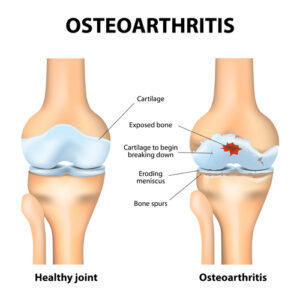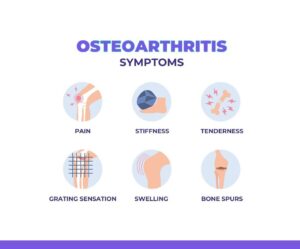Did you know that you can avoid knee and hip replacements surgery even when it is due to osteoarthritis?
Osteoarthritis is the most common reason for knee and hip replacement surgery,
Due to aging, people suffer serious pain while walking, climbing stairs, and getting in and out of chairs. Initially, your doctor tries to manage the pain and suppress the symptoms and in later stages, your doctor recommends joint replacement surgery. The replacement surgeries also come with their pros and cons.
However, up to a few years back – In absence of any other solution, the pros and cons were meaningless.
Coming back to the main question – “how to avoid knee and hip replacements surgery” and get the cure for the joints pains.
What was not possible up to a few years ago is possible today.
With the advancement in technologies and modern science, regenerative therapies offer great promise of developing osteoarthritis treatment options other than total joint replacement. These therapies are also known as stem cell therapies for joints.
Before we start discussing regenerative therapies or medicines, let’s first understand why osteoarthritis develops and what are its symptoms.
Why does osteoarthritis develop?

- Osteoarthritis is more common as we grow older.
- Osteoarthritis is compounded by excess body weight in several ways, and the more you weigh, the higher your risk. Weight gain puts strain on weight-bearing joints like your hips and knees. Fat tissue also produces proteins that can cause harmful inflammation in and around joints.
- Osteoarthritis can be developed by bad injuries while participating in sports or as a result of an accident. Even injuries that appear to have healed many years ago can put you at risk for osteoarthritis.
- If you play sports then repetitive stress on a joint will keep building up, that joint may develop osteoarthritis over time.
- Some people who are born with faulty cartilage or malformed joints will develop osteoarthritis.
- Diabetes and an overabundance of iron in the body are two examples (hemochromatosis) that can cause osteoarthritis.
Common symptoms of osteoarthritis

- Joint pain during or after movement.
- Joint stiffness, when you first wake up or after a period of inactivity.
- Joint tenderness, When you apply light pressure to or near your joint.
- Reduced range of movement of joints.
- Grating sensation and popping or crackling sounds from joints.
- Swelling due to inflammation of the soft tissues around the joint.
- Feeling of hard lumps in your joints.
Let’s now understand why stem cell therapy is an alternative to joint replacement surgery.
Why is stem cell therapy is alternative to knee and hip replacements surgeries?

The stem cell is the basic building block of our body and can convert itself to any other type of cell to regenerate the damaged tissue.
These cells have the ability to develop into a variety of cell types, including muscle, bone, and, most importantly, cartilage.
The conventional medical science typically approaches first the management by medication and then Physiotherapy, and at last stage Joint replacement surgeries. Nobody wants to undergo surgery and tends to avoid joint replacement surgery as far as possible. Moreover, joint replacement surgery definitely helps to overcome the pain but the additional restrictions in joint movements last till the last breath.
Stem cell therapy is focused on correcting the damage to the tissues which cause the pain. Stem cells are placed near damaged cartilage. The injected stem cells transform themselves into cartilage tissue later on.
Hence, Stem cell therapies’ main aim is to relieve pain, reduce inflammation, and regenerate or replace joint tissues.
Stem cell treatments help in repairing damaged joints in a variety of ways, including
- Modulating the immune system
- Regenerating cells that can be directed to form cartilage
- Transplanting stem cell-generated cartilage
- Stimulating a patient’s own cells for regeneration
- Relieve from pain
- Maintaining stability
Benefits of Stem cell Therapy over Joint replacement surgeries

- Injection based therapy: Stem cell therapy is an injection-based therapy wherein the stem cells are extracted from your own body and reinjected in your joints after processing them in specialized laboratories.
- Avoiding surgical complication: Joint replacement surgery is a major surgery wherein the natural joints are removed and metallic or ceramic-based joints are connected with the bones. The newly implanted joints are aligned properly to ensure that the new joints behave as close as possible to natural joints. Every surgery has its own complications. Be it due to anesthesia, or pain due to surgical cuts in the body, or post-surgery infections. There are certain percentage of cases where any of the above complications may come after surgery. Since stem cell therapy is an injection, based there is no such risk involved.
- No Recovery time: After every surgery, the body takes time to heal from the wound created during the surgery and the patient has to be under critical monitoring in the hospital. Most of the hospitalization time patient is bedridden. Since there is no surgery involved, there is no injury recovery time.
- No risk of any error in alignment: In 5 to 10% of the cases, people feel pain in joints even after the joint replacement surgery. These paints are clinically attributed to errors in the alignment of bones with the new implanted joints. Since there are no artificial joints are implanted in stem cell therapy, there is no risk of any such accidental errors.
- Safe and no risk of infections: When the artificial joints are plugged into the natural bone, there are risks of some infections which is observed in 5 % of the surgeries. There is no such risk as no artificial body is implanted into the body.
- Natural movements of joints are not compromised: The new artificial joints have certain restrictions in the range of movement of joints. For example, People with implanted joints cant sit on Indian potty seats and in any similar position. In stem cell therapy, your own joints are repaired with the regenerative capabilities of stem cells. So the joint movements remain natural and thus the movement range is natural and not restricted.
- No risk revision surgery: Artificial implants are having a life of 15-20 years. In most of the cases when this life of joint expires, revision surgery is recommended. Beyond the inconvenience of the second surgery, the implants of revision surgery are typically three to four times costlier than the implants used in normal joint replacement surgery. In stem cell therapy, since your original joints are repaired with the help of your own stem cells, this risk is also eliminated.
These are the main benefits why people are preferring stem cell therapy over conventional joint replacement surgery.
Conclusion
Stem cell therapy used the body’s own healing mechanisms to help repair, regenerate, and slow the deterioration of body tissues like cartilage.
If you are the right candidate for stem cell therapy, you will not only able to avoid the surgery but also get relief from your pains and symptoms with natural movements while maintaining the natural strength of bone.
To know more about stem cell therapy for joint pains please visit Stemcell therapy for knee pain and Stem cell therapy for hip pain.
If you want to get in touch with us for a specific question, you can get in touch with us.
FAQ
What is the current status of Stem cell therapy from the regulatory framework?
The stem cell-based therapy is in the research phase and not yet formally approved by ICMR. However, the application of stem cells, popularly known as bone marrow transplants, in blood-related disorders is approved by ICMR.
References
https://www.ncbi.nlm.nih.gov/pmc/articles/PMC5393127/
https://www.ncbi.nlm.nih.gov/pmc/articles/PMC4590943/




